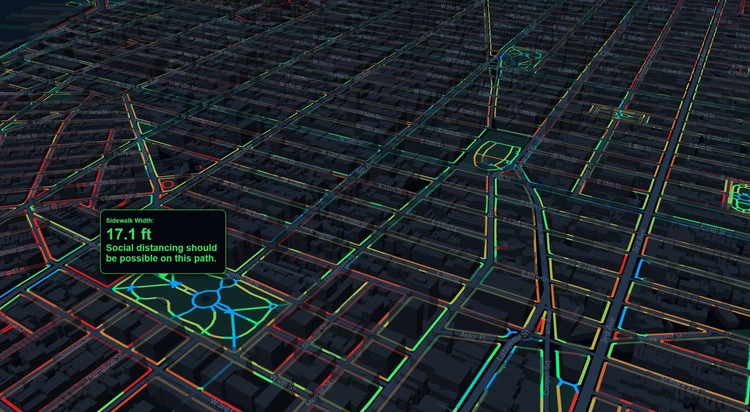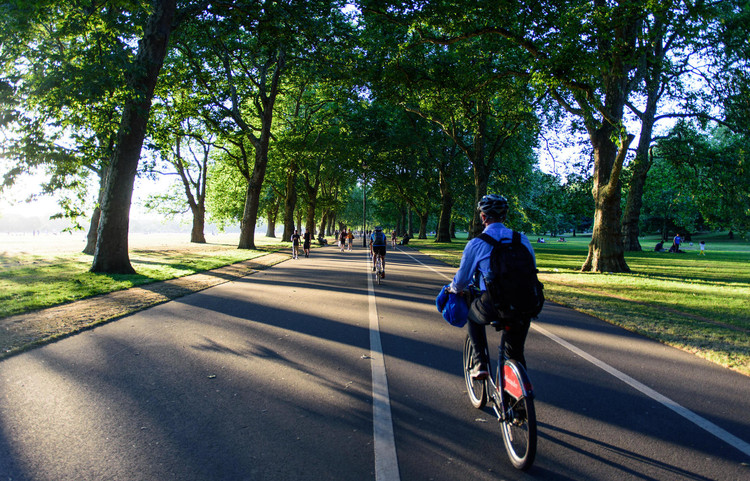
The pandemic provided a unique circumstance for city-scale experiments regarding mobility, while immediate responses showed the transformative power of tactical urbanism. In many cities, the measures meant to ensure social distancing are to be kept in place post-pandemic, paving the path towards recovery with less traffic and more outdoor activities. How did the pressure of rethinking streets, functions, and transportation systems transform public space in 2020?
Proposals adapting public space to the new circumstances unfolded by the pandemic inundated the architecture media in the first months of this year. The efforts were concentrated on several types of interventions: rapid adaptations of the public space to social distancing guidelines, strategies to help businesses stay afloat by moving their activities outdoors, and restructurings of transportation systems.
Immediate Response

In the first months of the pandemic, cities needed to put in place a safe transportation strategy, while ensuring social distancing. Also, public space had to be adapted to accommodate activities that were no longer safe to be carried out indoors, from food markets, dining, to sports and recreational activities.

In early summer, The National Association of City Transportation Officials (NACTO) has released a series of guidelines for adapting streets to new uses during and after the pandemic Streets For Pandemic Response and Recovery provided city officials with comprehensive strategies for adjusting public space to the unique situation, including policies for bike lanes, sidewalks extensions, slow streets, outdoor dining, and markets. Since the release, the project has been continually revised and expanded, addressing the changing conditions of the pandemic and providing the latest input from practice. The urban pockets of nature needed to conform to social distancing rules as well. New York's Domino Park introduced a series of painted circles, ensuring visitors follow social distancing rules. The idea has since been replicated in numerous parks around the world, from Ibirapuera Park in Brazil to parks in Istanbul.
Outdoor Dining

Trying to help the service industry stay afloat, many cities have sought ways to move restaurants' activity outdoor, allowing them to make use of the public space. Al fresco dining, already popular in Europe up to this point, has been implemented in numerous cities around the world, with municipalities putting in place regulations. At the same time, designers developed installations, projects, and design strategies for implementation.

The Lithuanian capital Vilnius supported the safe re-opening of gastro businesses this spring by allowing them to make use of the public space, turning outdoor areas into a vast open-air café. The municipality of Montreal commissioned several public space refurbishments, to restart urban life and help the service industry after the lockdown. One of the installations, the TULIP by ADHOC architects, adds a social component to an existing park in the city, allowing citizens to re-appropriate the urban space while respecting sanitation norms. Similarly, HUA HUA Architects proposed the Gastro Safe Zone program, aimed to help gastronomic businesses by regulating outside eating areas in tune with the social distancing measures. The prototype has been installed in Brno, Czech Republic in April.

In June, New York initiated the Open Restaurants Program, allowing these establishments to expand their activity onto public space. The measure proved widely successful, and the municipality decided to make it permanent and year-round, as part of New York's long-term recovery plan.
Knowledge of the City

Some municipalities and designers came up with different solutions to mitigate the spread of the virus in public spaces and make it easier for people to keep social distancing. Amsterdam launched a regularly updated map showing the crowded and quiet spots of the city. Along the same lines, urban planner Meli Harvey developed a map of New York showing the width of sidewalks, highlighting the possibilities for social distancing around the city.
City-Level Policies

Cities around the world which for years have made efforts to change their transportation systems and break away with the hegemony of the car have been faced with the strangest opportunity to act on these plans. The pandemic interventions provided hard evidence of the potential success of bike lanes, pedestrian streets, and slow mobility roads. Due to the unprecedented situation, these decisions concerning public spaces became part of cities' emergency response, which meant fast approval and implementation processes, as well as a better public reception.
b
In April, Milan announced its new transportation plan, aimed at reducing car usage after lockdown. The new ambitious mobility vision sought to repurpose 35 km of roads by prioritizing cycling and walking. The Strade Aperte plan, which was inaugurated after the spring lockdown, represents not only response and adaptation to the new conditions imposed by the pandemic but a chance to rethink transportation and public space entirely, fast-tracking a process the city was working towards for years. Similarly, Paris has also responded to the pandemic by creating more space for cyclists and pedestrians, while limiting the number of cars in the city center. The city converted 50 kilometers of traffic lanes into cycling paths, in a move initially announced as temporary, but which is now to be made permanent, as cycling has proved to be a viable commuting choice for Parisians.
"You never want a serious crisis to go to waste" is what Rahm Emanuel, the former mayor of Chicago, said a few years ago. This year has forged a new consensus around the need for pedestrian areas, green spaces and has brought long-awaited changes to major city centers, be it temporary. Activists and planners hope that the lessons learned during these challenging times will pave the way for long term change.
This article is part of the ArchDaily Topic: 2020 In Review. Every month we explore a topic in-depth through articles, interviews, news, and projects. Learn more about our monthly topics. As always, at ArchDaily we welcome the contributions of our readers; if you want to submit an article or project, contact us.















